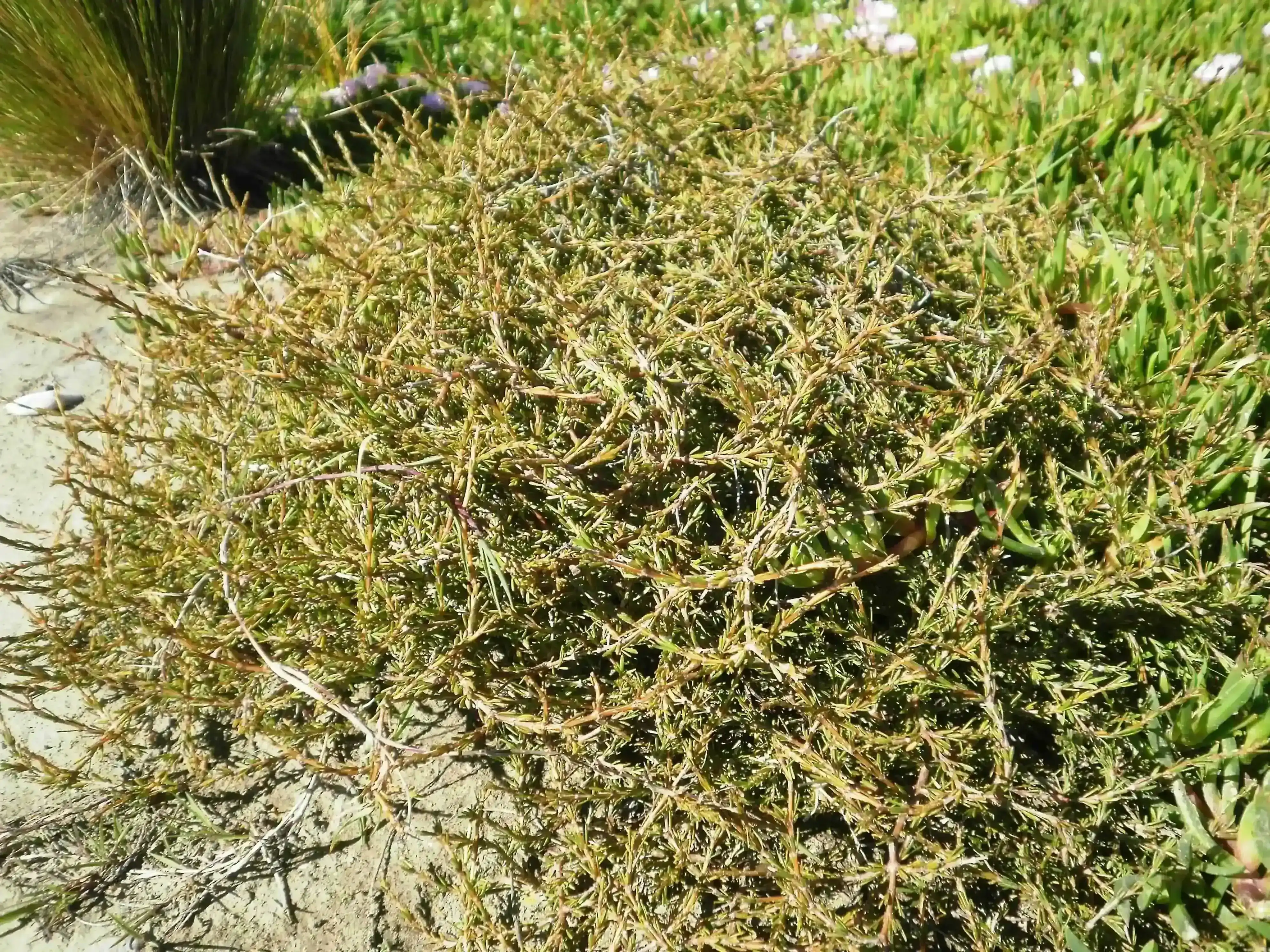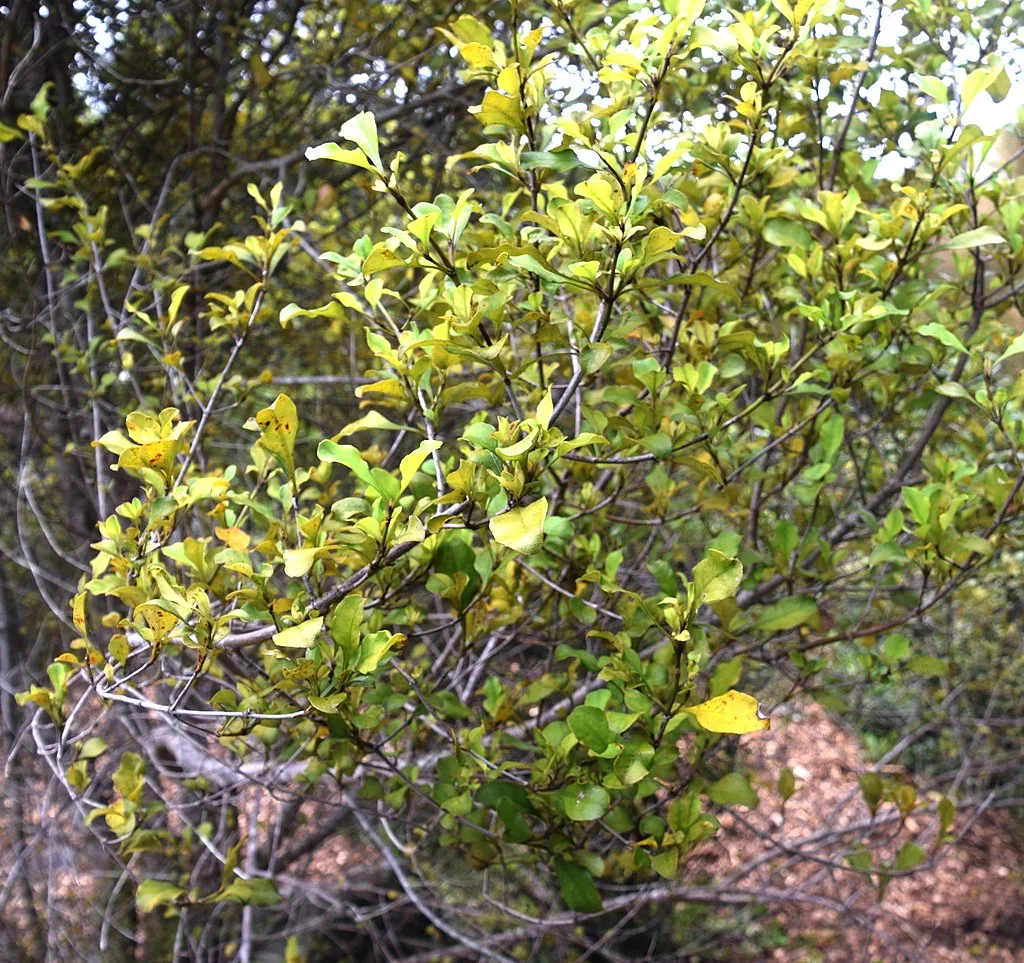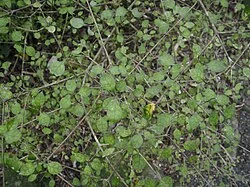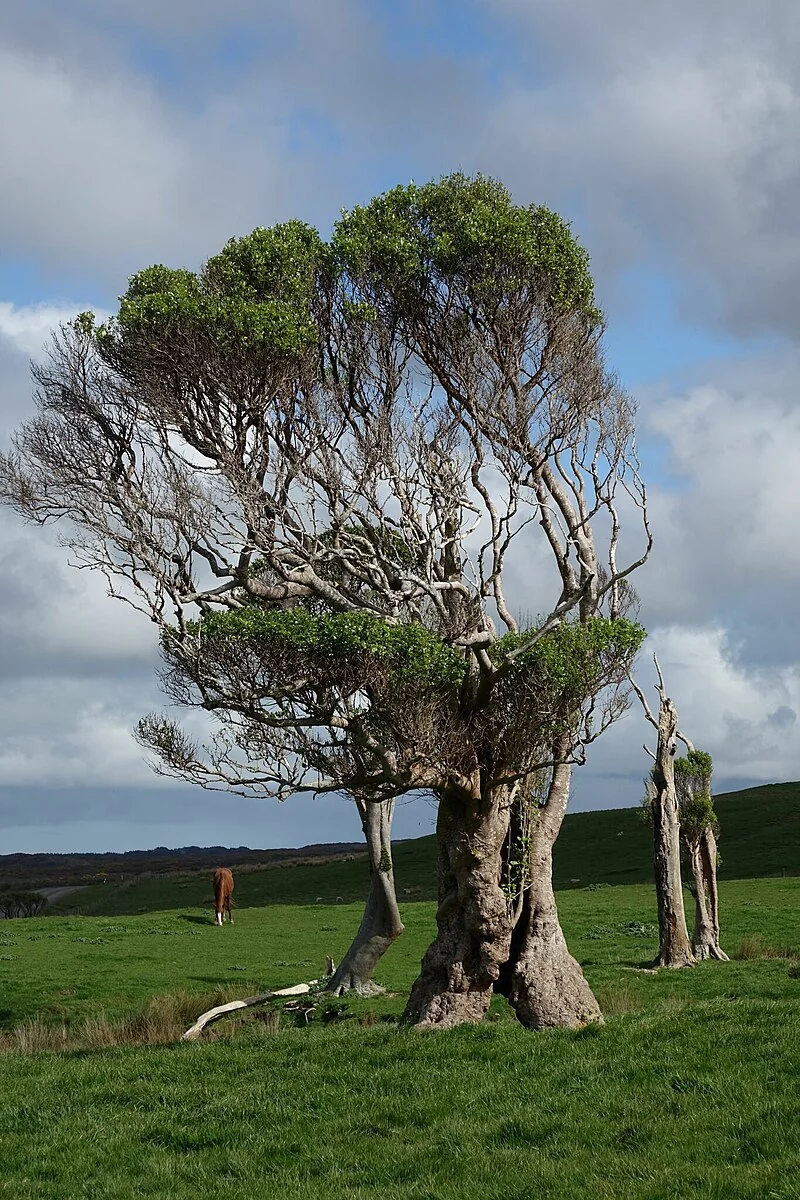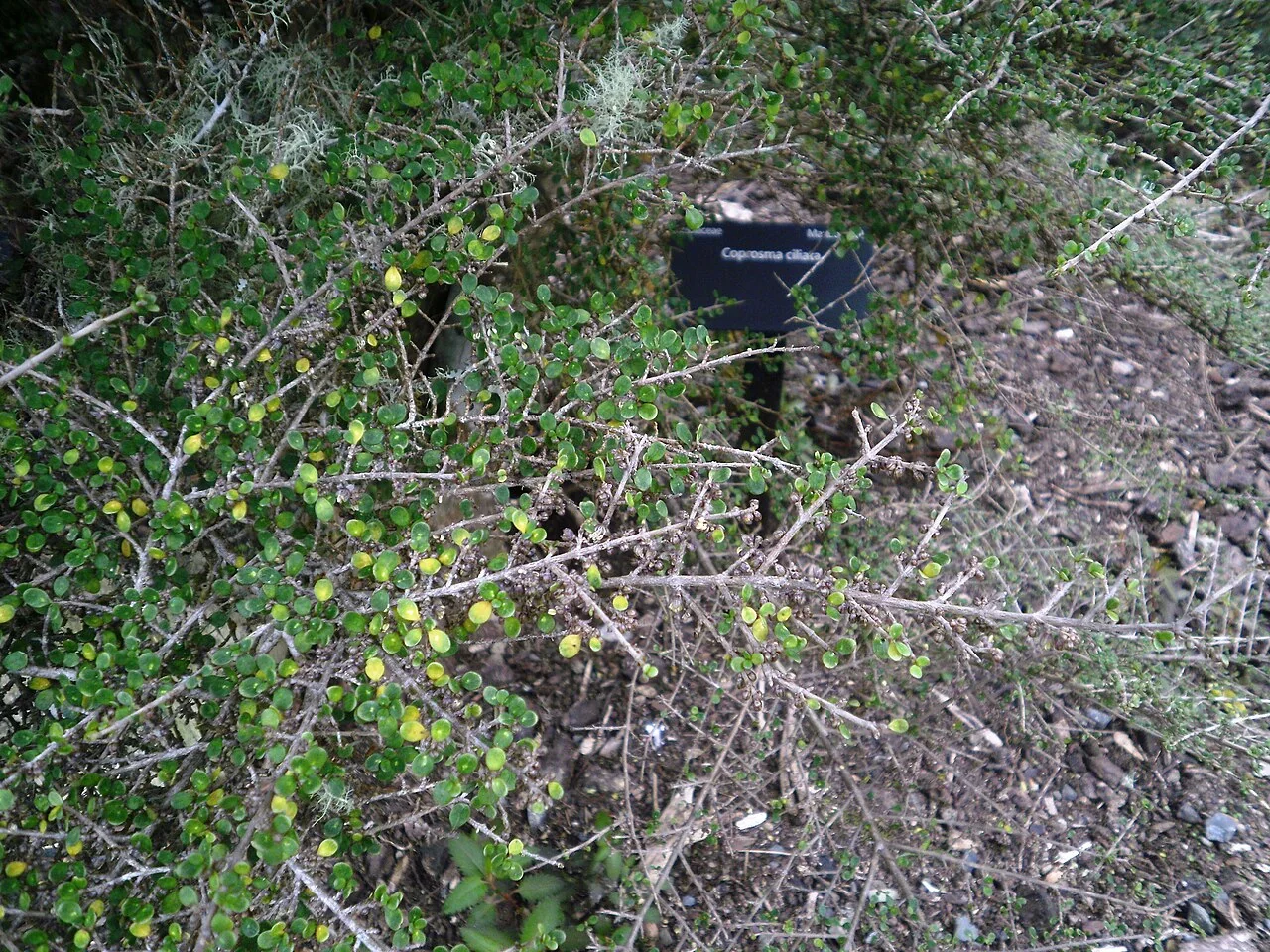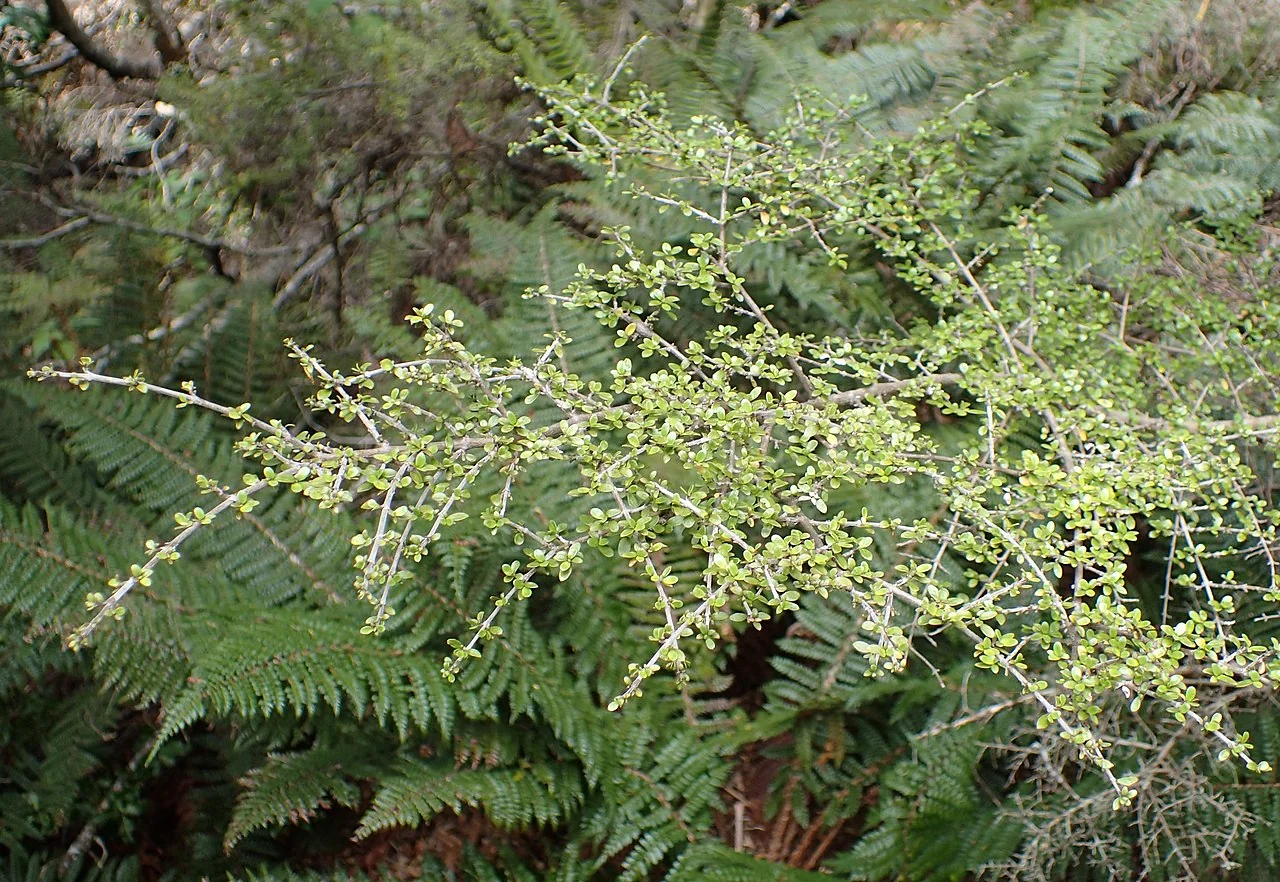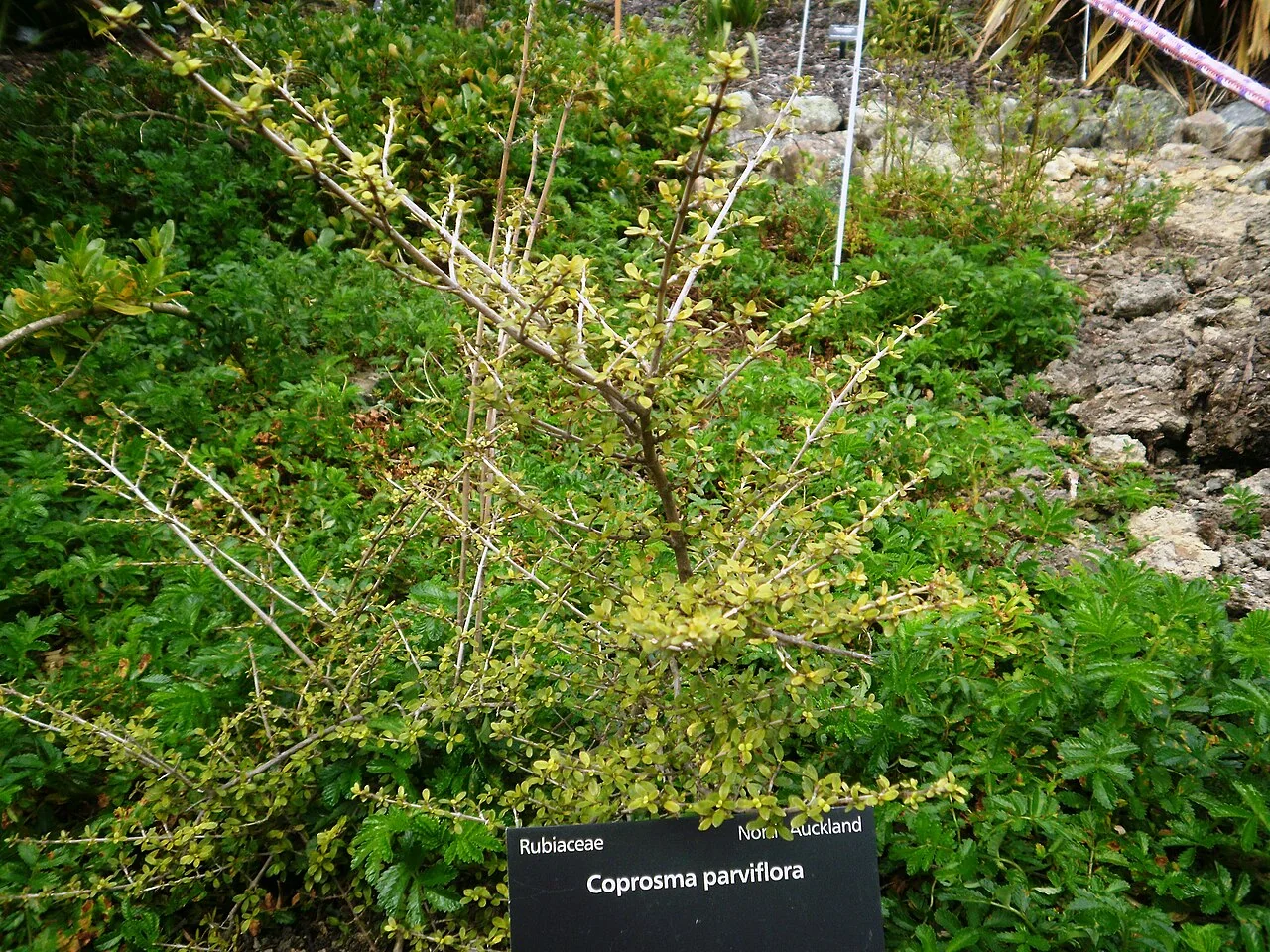
Small-Leaved Coprosma
Coprosma parviflora
Coprosma parviflora , known as Small-flowered Coprosma, stands as a distinctive and increasingly rare native shrub that embodies both botanical refinement and conservation urgency through its specialized northern distribution and unique morphological characteristics within New Zealand's diverse Coprosma genus . This elegant bushy shrub, endemic to the Three Kings Islands and northern North Island from Kaipara Harbour northward , grows up to 5 meters tall with a characteristic branching pattern of flattened wide-angled branches and densely hairy branchlets that give it a distinctive fuzzy appearance toward the tips. Most remarkable for its botanical precision suggested by its scientific name meaning "small-flowered," this species produces minute green and white flowers from August to September, followed by variable-coloured fruits ranging from white to pink to dark violet that ripen from March to April, demonstrating unusual diversity in fruit coloration within a single species. Distinguished from related Coprosma species by its small oval leaves measuring 7-12mm long with tiny hairs on the undersides and its specialized northern range, Small-flowered Coprosma has experienced significant range contraction, having become extinct in Auckland City while maintaining populations in more northern locations. With its fleshy drupes dispersed by frugivorous birds, delicate fuzzy growth habit, and status as regionally critical in Auckland despite being nationally not threatened, Small-flowered Coprosma represents both the subtle beauty of New Zealand's endemic shrub diversity and the conservation challenges facing species with restricted distributions in areas of high development pressure. native shrubs .

Plant Description
Botanical Features
Coprosma parviflora , also known as Small-flowered Coprosma or Leafy Coprosma, is a bushy shrub endemic to New Zealand, typically growing up to 5 meters tall. It has a distinctive architectural presence with its interlaced, flattened, wide-angled branches. Young stems are covered with hairs, and the plant bears clusters of small, oval leaves, 7-12mm long, which have tiny hairs on their lower surface. The flowers are small, green or white, and are followed by fleshy drupes that can be white, pink, or dark violet. This species is found on the Three Kings Islands and in the northern North Island, thriving in sheltered forest environments with well-drained but moisture-retentive soils.
Quick Facts
Quick Facts Overview
| Scientific Name | Coprosma Parviflora |
|---|---|
| Height | 1-3 meters |
| Spread | 1-2 meters |
| Water Needs | Moderate |
| Light | Partial shade to full sun |
| Frost Tolerance | Moderate to high (hardy to -10°C) |
| Salt Tolerance | Low to moderate |
| Growth Rate | Slow to moderate |
| Lifespan | 40-80 years |
Climate Best Suited to
Coprosma parviflora grows from sea level to 1200 meters elevation in lowland and montane forests throughout New Zealand. It thrives in cool, moist climates with consistent rainfall and performs best in sheltered forest conditions with filtered light and high humidity.
Regional Suitability
| Whangārei | Ideal |
| Auckland | Ideal |
| Hamilton | Suitable |
| Rotorua | Suitable |
| Tauranga | Ideal |
| Gisborne | Ideal |
| New Plymouth | Ideal |
| Whanganui | Ideal |
| Palmerston North | Suitable |
| Napier | Ideal |
| Wellington | Ideal |
| Nelson | Ideal |
| Christchurch | Suitable |
| Dunedin | Suitable |
| Invercargill | Suitable |
| City | Climate Suitability |
|---|
Natural Habitat and Distribution
Natural Habitat and Distribution Overview
Coprosma parviflora occupies one of the most geographically restricted distributions among New Zealand's endemic flora, confined to the Three Kings Islands and the northern tip of the North Island, representing a classic example of northern endemic biogeography.
The species ' natural distribution encompasses the remote Three Kings Islands, located approximately 55 kilometers northeast of Cape Reinga, where it forms part of the unique flora adapted to these isolated island conditions. These islands support numerous endemic species that have evolved in isolation from mainland influences, creating distinctive plant communities found nowhere else in New Zealand.
On the mainland, the species historically occurred from Te Paki in the far north south to Auckland City (Remuera), but has suffered significant range contraction, becoming extinct in the Auckland region . Current mainland populations are restricted to areas from the Kaipara Harbour northward , representing a significant reduction from its historical distribution.
Within its natural range, Small-flowered Coprosma typically establishes in sheltered forest environments, where it benefits from the warm, humid conditions characteristic of northern New Zealand. The species shows preference for well-drained but moisture-retentive soils that remain consistently moist without becoming waterlogged, reflecting adaptation to the reliable rainfall patterns of northern regions.
The natural habitat represents some of New Zealand's warmest and most humid terrestrial environments, characterized by mild winters, warm summers, and high atmospheric moisture levels that support lush forest growth. These conditions create optimal environments for the species' specialized requirements, including the high humidity needed for proper development of the characteristic fuzzy branchlets.
The restriction to northern latitudes reflects climatic limitations, with the species apparently unable to tolerate the cooler, more variable conditions found further south. This climatic sensitivity has likely contributed to its vulnerability to environmental changes and habitat modification in the heavily developed Auckland region .
Plant Conservation
Northern Range Conservation and Endemic Protection
Coprosma parviflora (Small-flowered Coprosma) is currently classified as "Not Threatened" under the New Zealand Threat Classification System, but its restricted distribution to the upper North Island and Three Kings Islands makes it an important species for regional conservation efforts. This endemic species represents a unique component of northern New Zealand's flora, with specialized adaptations to the distinct climatic and ecological conditions found in these northernmost parts of the country.
The species faces particular conservation challenges related to its limited range, including potential impacts from invasive plants, habitat modification, and climate change effects on its specialized northern ecosystems. Island populations are especially vulnerable to introduced pests and weeds that can alter forest understory composition. Conservation efforts focus on protecting remaining native forest habitats, controlling invasive species that threaten endemic plant communities, and monitoring population trends across its range.
Restoration projects in northern regions often incorporate Small-flowered Coprosma to restore natural forest understory diversity and support native bird populations through its berry production. The species' role in providing food for frugivorous birds makes it valuable for maintaining ecological connectivity between forest fragments, while its genetic uniqueness within the Coprosma genus contributes important evolutionary diversity to New Zealand's endemic flora.
Growing Requirements
Soil Requirements
Forest loams and well-drained soils suit Coprosma parviflora best.
- Prefers free -draining, humus-rich soil
- Neutral to slightly acidic pH (6-7)
- Avoids prolonged waterlogging
- Benefits from organic mulch to maintain moisture
Light Requirements
Typical of understory shrubs, it thrives with filtered light.
- Best in partial shade to dappled light
- Tolerates morning sun with afternoon shade
- Full shade slows growth but is tolerated
Water Requirements
Moisture-retentive soils help establishment; mature plants are resilient.
- Moderate watering during first 1-2 years
- Drought-tolerant once established in shaded sites
- Mulch to reduce summer evaporation
Planting Guide
When to Plant
Best planted in autumn or spring for reliable establishment.
Site Selection
- Partial shade with shelter from hot winds
- Moist, well-drained soils enriched with compost
Ecological Role and Ecosystem Functions
Small-flowered Coprosma serves as a critical component of northern New Zealand's endemic ecosystems, providing essential ecological services within the specialized environments of the Three Kings Islands and northern North Island forest communities.
Northern Ecosystem Functions
- Endemic Habitat Structure: Provides understory structure in specialized northern forest communities
- Wildlife Food Resources: Variable-coloured berries support diverse frugivorous bird species
- Microhabitat Creation: Dense branching creates shelter for insects and small native animals
- Genetic Diversity: Contributes unique genetic resources to northern ecosystem resilience
Conservation Ecosystem Services
- Species Indicator: Serves as indicator for healthy northern endemic plant communities
- Seed Dispersal Networks: Frugivorous dispersal maintains connectivity in fragmented northern habitats
- Pollination Support: Tiny flowers support specialized small insect pollinators
- Endemic Community Integrity: Essential for maintaining authentic Three Kings Islands ecosystem character
Uses and Significance
Garden Uses
- Coprosma parviflora is an excellent choice for understory planting in native woodland schemes, providing subtle texture and contributing to the forest-like feel of a garden.
- It can be used for informal hedging in shaded boundaries, creating a soft, natural barrier while offering year-round foliage interest.
- This species is ideal for habitat plantings for small birds, as its dense branching provides shelter and its berries offer a valuable food source, enriching garden biodiversity.
Cultural Significance
Traditional Uses and Values
Small-leaved Coprosma ( Coprosma parviflora ) holds cultural significance as part of the diverse Coprosma family, many species of which were traditionally used by Māori for various purposes, including medicinal applications (rongoā) and as food sources. Its presence in forest ecosystems also contributes to traditional ecological knowledge, highlighting the interconnectedness of native flora and fauna.
Professional Landscaping Applications
Small-flowered Coprosma offers unique opportunities for specialized landscape design, particularly valuable for collectors and conservation-minded gardeners interested in rare northern endemic species.
Specialized Design Applications
- Endemic Collections: Essential for Three Kings Islands or northern endemic plant collections
- Conservation Gardens: Perfect for gardens focused on rare and endangered native species
- Intimate Spaces: Ideal for small-scale gardens where subtle details can be appreciated
- Educational Landscapes: Excellent for botanical gardens and educational plantings about endemic species
Professional Design Benefits
- Subtle Beauty: Provides refined , understated elegance in appropriate settings
- Conservation Value: Contributes to ex-situ conservation through cultivation
- Unique Characteristics: Variable fruit colours and fuzzy branchlets create distinctive garden features
- Educational Impact: Raises awareness about New Zealand's endemic flora and conservation challenges
Seasonal Care Calendar
Spring
- New small leaves emerge with fresh green colour
- Extremely tiny flowers appear (often barely visible)
- Good time for planting in forest garden settings
- Begin regular watering for establishment
Autumn
- Tiny orange to red berries ripen in small clusters
- Small birds attracted to accessible berry displays
- Good time for collecting berries for propagation
- Attractive autumn interest despite small size
When to Prune and How Much
When to Prune and How Much Overview
Light pruning only. Clip after fruiting to maintain shape and remove weak or wayward stems.
How to Grow Small-Leaved Coprosma
From Fresh Colourful Berries
Fresh colourful berry propagation represents the most reliable and natural method for growing Small-leaved Coprosma, taking advantage of this distinctive northern endemic species' exceptional fruit production and natural dispersal strategy that has enabled it to establish across challenging environments from Three Kings Islands to coastal Northland sites. This hardy twiggy shrub produces abundant berries in variable colours including white, pink, and dark violet that provide excellent opportunities for propagation while supporting the species' natural frugivory dispersal cycles essential for coastal and forest margin ecosystem function. The species' remarkable adaptation to diverse growing conditions from exposed coastal sites to forest understories makes it particularly valuable for challenging garden situations requiring plants capable of handling variable moisture levels while providing important winter food resources for native birds through their attractive berries. Fresh berry propagation allows cultivation of genetic diversity essential for healthy populations while enabling gardeners to appreciate the natural colour variation in fruit production that characterizes wild populations of this regionally endemic northern species. Collect ripe berries during autumn and winter when fruits have achieved their full colour development ranging from white through pink to dark violet, timing collection to coincide with peak seed maturity for optimal viability and germination success. Choose berries that are fully developed, firm, and show good colour intensity typical of mature fruit, avoiding any that appear damaged, diseased, or prematurely dropped which might indicate compromised seed quality or reduced viability. Process berries immediately after collection by macerating in water and thoroughly cleaning seeds, using gentle rubbing under running water to separate seeds from fruit pulp that could inhibit germination or promote fungal growth during establishment. Clean seeds by repeated washing until all fruit debris is removed, as any remaining pulp can significantly interfere with germination success in coprosma species, retaining the viable seeds that settle to the bottom while discarding floating material. Prepare optimal germination medium using free-draining seed-raising mix with good moisture retention characteristics, ensuring pH levels between 6.0-7.0 that support healthy development for this adaptable northern species. Sow fresh seeds immediately after processing in autumn, covering lightly with 2-3mm of fine sand to provide optimal conditions for emergence while maintaining protection from drying out that can quickly kill developing seedlings. Provide optimal environmental conditions including consistent temperatures between 15-20°C and bright light that supports germination while maintaining steady moisture without waterlogging throughout the germination period. Maintain careful moisture management throughout the 4-8 week germination period, ensuring growing medium remains consistently moist but never waterlogged while monitoring for early emergence signs that indicate successful seed activation. Young seedlings develop at moderate rates while establishing the root systems necessary for adaptation to variable growing conditions, requiring protection from direct sunlight and environmental stress during early establishment phases when they are most vulnerable to damage. Transplant successful seedlings when they reach 5-8cm height and have developed sufficient root systems to handle garden conditions, providing growing environments that support transition to permanent locations where they can contribute to native bird habitat. This easy propagation method makes Small-leaved Coprosma an excellent choice for gardeners seeking reliable results with northern native plant cultivation while contributing to conservation efforts through expanding populations of this regionally significant endemic species.
From Semi-Hardwood Cuttings
Semi-hardwood cutting propagation offers an excellent vegetative method for growing Small-leaved Coprosma that preserves the exact genetic characteristics of superior parent plants while providing reliable results for gardeners seeking to maintain specific traits including berry colour, growth habit, or adaptation characteristics that characterize exceptional specimens of this valuable northern endemic species. This approach is particularly valuable for propagating plants that demonstrate superior hardiness, attractive berry production, or other desirable traits that can be preserved through careful vegetative propagation techniques suited to this easily rooted coprosma species. The method works especially well with Small-leaved Coprosma because of this species' natural ability to develop adventitious roots readily under appropriate growing conditions, making it suitable for both home propagation and commercial nursery production of this increasingly appreciated native shrub. Take 8-10cm semi-hardwood cuttings during late summer to early autumn when current season's growth has achieved optimal maturity for rooting while retaining sufficient vigor for successful establishment under controlled propagation environments. Select healthy, vigorous shoots from middle portions of branches that display the characteristic small oval leaves with tiny hairs underneath and robust growth typical of healthy Small-leaved Coprosma development, avoiding both very soft growth and completely hardened wood that may resist rooting. Cut sections with clean, sharp secateurs just below a node, ensuring each cutting includes at least 2-3 nodes while selecting material that represents the best characteristics of the parent plant including compact growth habit and the distinctive small-leaved foliage that characterizes this species. Remove lower leaves carefully to reduce transpiration stress while retaining sufficient photosynthetic capacity in upper leaves, taking care not to damage the small leaves that provide energy for root development during the establishment period. Create a light wound by making a small nick at the base of cutting to expose more tissue where new roots will develop most readily, using gentle techniques that enhance root initiation without causing excessive damage to cutting material. Apply rooting hormone powder or solution if desired, though Small-leaved Coprosma often roots successfully without hormone treatment, using formulations appropriate for easy-rooting native species to enhance success rates. Insert prepared cuttings into well-draining cutting mix composed of equal parts quality propagation medium and coarse sand or perlite, ensuring excellent drainage while maintaining the consistent moisture levels essential for successful root development. Maintain optimal environmental conditions including high humidity through misting systems or humidity domes and consistent temperatures around 18-22°C that support rapid root development while preventing cutting stress. Provide bright, indirect light that supports photosynthesis without causing excessive transpiration stress, or use specialized propagation facilities with bottom heat that can accelerate rooting in cool conditions. Monitor cutting development throughout the 3-6 week rooting period, maintaining consistent environmental conditions while watching for signs of successful root development including new shoot growth and resistance when gently tested. Root development occurs rapidly as cuttings establish the fibrous root systems characteristic of mature Small-leaved Coprosma adapted to variable growing conditions, typically showing successful establishment within three weeks under optimal conditions. Pot successful cuttings into sandy, well-drained mix and harden off gradually before planting into permanent garden positions, providing growing environments that support transition from propagation to landscape cultivation where they can develop their characteristic dense, twiggy habit and seasonal berry production.
From Dense Shelter Plantings
Dense shelter planting establishment provides an excellent approach to growing Small-leaved Coprosma that maximizes this species' natural characteristics as a densely interlacing, twiggy shrub while creating effective windbreaks and wildlife habitat features that support both garden function and native biodiversity conservation. This method is particularly valuable for gardeners seeking to establish protective shelter belts, bird habitat areas, or naturalistic plantings that take advantage of this species' excellent tolerance to pruning and ability to form dense, protective vegetation while providing seasonal interest through variable berry colours and reliable winter food resources for native birds. Small-leaved Coprosma serves as an exceptional shelter plant due to its natural dense growth habit, excellent response to regular pruning, and ability to develop interlacing branching structures that provide effective wind protection while supporting beneficial wildlife including berry-eating birds essential for garden ecosystem health. Begin by planning shelter belt layout and spacing according to desired mature shelter dimensions, allowing appropriate distances between plants to encourage natural dense development while considering the species' moderate growth rate and ultimate mature size for effective long-term shelter establishment. Source multiple plants through combination of seed-grown specimens, cutting‑propagated plants, and nursery stock to ensure genetic diversity and uniform shelter development while maintaining the natural variation that supports healthy plant community establishment and berry colour diversity. Space shelter plants 1-1.5 m apart to encourage proper lateral growth development and natural shelter filling without creating excessive competition that can weaken individual plants or reduce flowering and fruiting performance essential for wildlife value. Prepare planting sites by improving soil drainage in poorly drained areas and incorporating organic matter to create optimal growing conditions that support rapid establishment and healthy long-term shelter development in various garden situations. Plant during optimal seasonal windows in autumn or spring when environmental conditions support rapid establishment before plants face stress from summer heat or winter cold that can challenge establishing plants during vulnerable phases. Implement regular pruning schedule throughout the growing season to encourage dense branching development and maintain desired shelter form while preserving flowering wood essential for seasonal berry production and wildlife food resources. Create structured pruning regime that promotes lateral growth development while maintaining shelter height and density, allowing natural flowering and fruiting cycles to provide seasonal wildlife resources and garden interest. Monitor shelter development and provide supplemental watering during establishment periods, reducing irrigation frequency as plants mature and develop the drought tolerance characteristic of established Small-leaved Coprosma adapted to variable northern growing conditions. Integrate with complementary native plants that enhance shelter ecological function and wildlife value, creating diverse habitat structure that supports various native bird species while providing enhanced garden ecosystem benefits including year-round shelter and seasonal food resources. Allow natural ecological processes including bird visitation during fruiting seasons to enhance shelter wildlife value, creating dynamic landscape features that provide practical wind protection while supporting native biodiversity conservation and creating attractive naturalistic garden areas with seasonal berry interest.
Pests and Diseases
Scale Insects
- Damage: Soft scale insects may occasionally infest foliage in sheltered garden conditions
- Symptoms: Yellowing leaves , sticky honeydew deposits on foliage
- Management: Improve air circulation, horticultural oil applications if severe
Fungal Issues
- Leaf Spot: Occasional fungal leaf spots in humid, poorly ventilated conditions
- Root Rot: Can occur in waterlogged soils or overwatered container plants
- Management: Ensure good drainage, avoid overhead watering, improve air circulation
Environmental Stress
- Sun Burn: Leaves may scorch in intense full sun without gradual acclimatization
- Drought Stress: Young plants sensitive to extended dry periods during establishment
- Management: Provide partial shade, maintain consistent moisture during establishment
Small-flowered Coprosma is generally hardy and pest-resistant when grown in appropriate forest-like conditions with good air circulation and proper drainage.
Bonus Tip
Expert Growing Advice
Small-leaved Coprosma ( Coprosma parviflora ) is a versatile native shrub that can be used to create dense, protective shelterbelts or informal hedges, especially in northern New Zealand gardens. Its fine-textured foliage and small berries provide year-round interest and food for native birds. Regular pruning can help maintain its compact form and encourage bushy growth, making it an excellent choice for structured native plantings.
